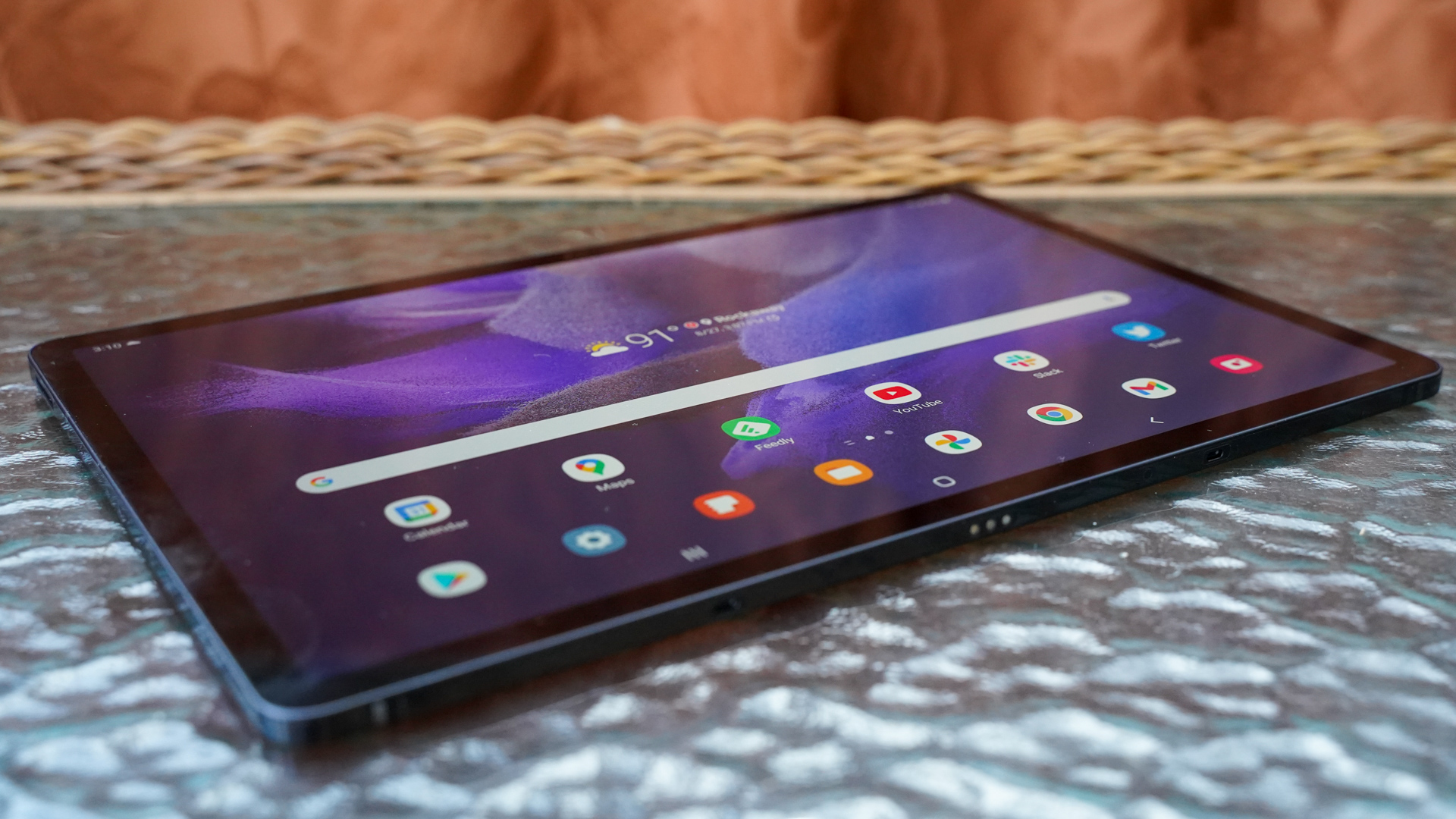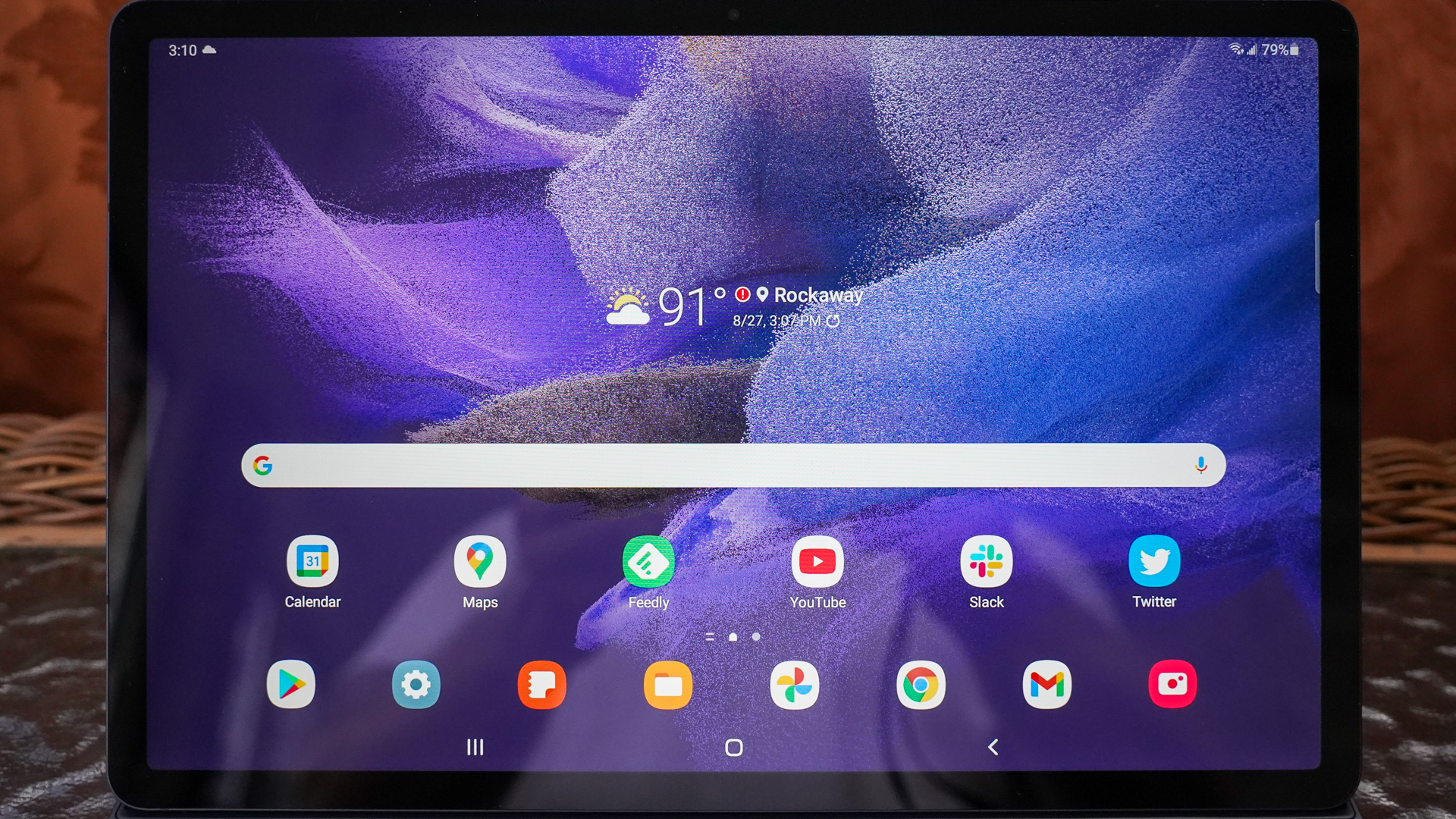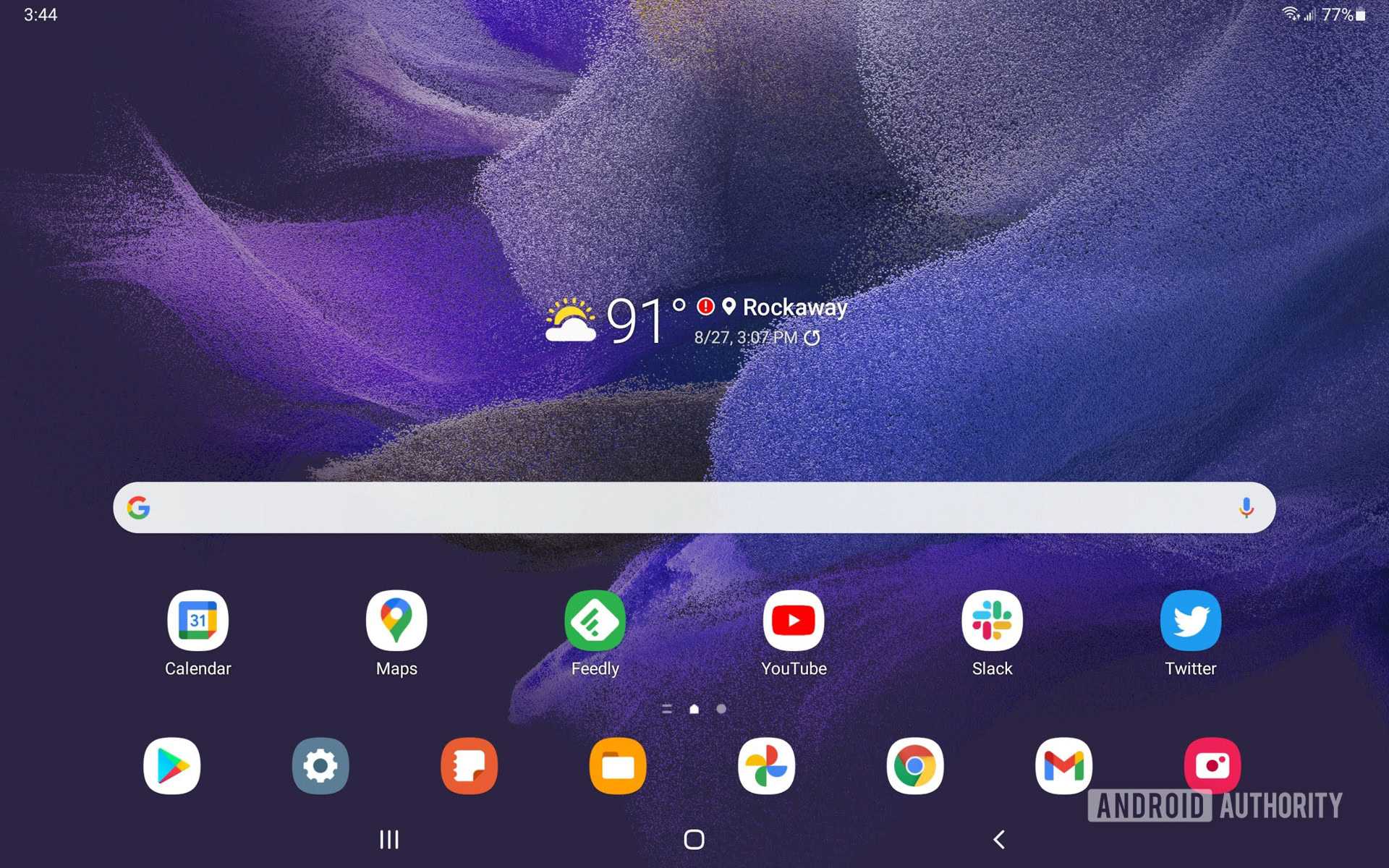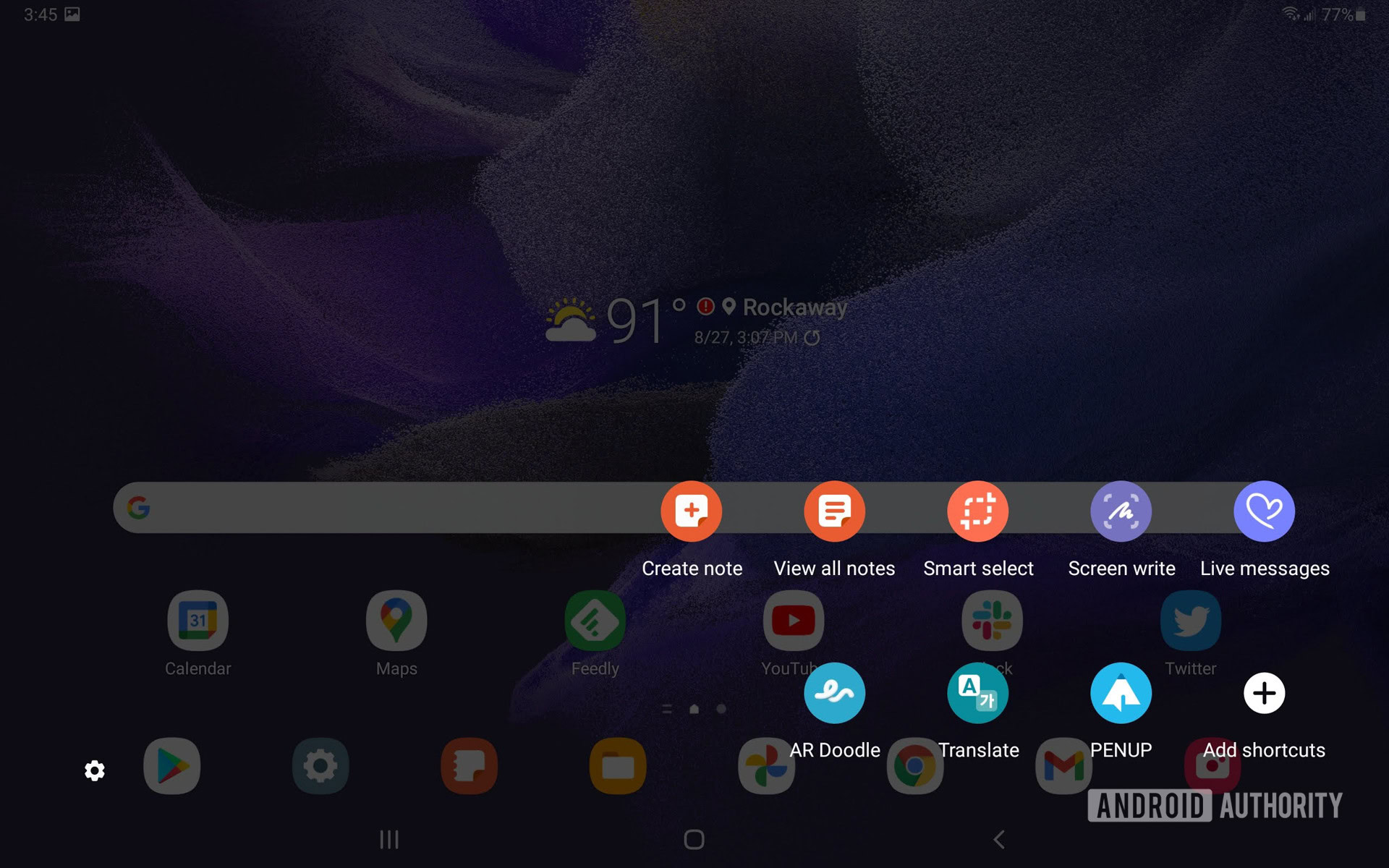Samsung’s latest tablet to reach the market is the Galaxy Tab S7 FE, a mid-range slate that distills the pricier Galaxy Tab S7 down to create a machine that’s still appealing while also being affordable. It tries to balance the form and function equation in a way that few other tablets at this price point can, making it a potential ideal buy for those who need to work as hard as they play.
Find out if this tablet is a fit for you in the Android Authority Samsung Galaxy Tab S7 FE review.
What you need to know about the Samsung Galaxy Tab S7 FE

- Samsung Galaxy Tab S7 FE (4GB/64GB): $529.99 / £519
- Samsung Galaxy Tab S7 FE (6GB/128GB): $599.99 / £559
- Samsung Galaxy Tab S7 FE (6GB/256GB): $679.99
- Samsung Galaxy Tab S7 FE with 5G (4GB/64GB): $669.99 / £589 / €649
The Samsung Galaxy Tab S7 FE (“Fan Edition”) is here. This tablet sits in the middle of Samsung’s tablet roster, between the less-expensive Galaxy Tab A7 and the full-blown Galaxy Tab S7 series. It dials back the feature list of the Galaxy Tab S7 tablets while keeping fan favorites, such as the design, to reach a lower price point. The idea is to offer most of the Tab S7 experience in a more affordable piece of hardware.
Samsung’s Tab S7 FE competes most directly with the Apple iPad Air line of tablets. Similar to the way Apple has its lineup structured, Samsung now has affordable, mid-range, and high-end tablets for different sets of buyers. The Tab S7 FE is for those who want more productivity capabilities rather than a simple slate for slacking off. Case in point, unlike many tablets, both budget and premium, the Galaxy Tab S7 FE comes with Samsung’s signature S Pen stylus included in the box.
See also: Your guide to the best tablets — Breaking down OS, options, and more
Samsung is selling four versions of the Galaxy Tab S7 FE. There’s an entry-level model with just 4GB of RAM and 64GB of storage, as well as pricier 6GB/128GB and 6GB/256GB options. There’s also a 5G version — the version we tested for review — that (inexplicably) ships only with the lower 4GB/64GB storage capacity. The 5G model supports service from AT&T, T-Mobile, Verizon, and US Cellular in the US and select carriers overseas. The tablet also comes in four colors: Mystic Black, Mystic Silver, Mystic Pink, and Mystic Green. The 5G variant is only available in Mystic Black. Storage and color options vary widely by country, so be sure to check you’re getting the model you want before you spend your cash.
Mirroring the way it sells its phones, Samsung is offering hundreds of dollars off the list price of the Tab S7 FE when ordered via its website. At the time of writing, the tablet has been available for pre-order in the US for several weeks already and the trade-in deals are still viable. If you’re still in the pre-order window, we suggest you go direct to Samsung to buy the tablet.
How is the hardware?

In a word, impeccable. Samsung knows how to create compelling hardware and it has done so once again with the Galaxy Tab S7 FE.
This tablet isn’t for the faint of heart. It adopts the larger form factor of the Tab S7 Plus, which means a 12.4-inch screen rather than the smaller 11-inch screen of the standard Tab S7. It’s a platter-like aluminum slab that’s more rectangular than square thanks to the 16:10 aspect ratio of the screen. It measures 284.8 x 185 x 6.3mm and weighs in at 608g — making it incredibly thin and light.
Like the competing Apple iPad Air, it has flat glass on the front and flat metal side edges that form sharp angles. The quality of the materials and assembly is, as expected, top-notch. The black color of our 5G test unit looks sophisticated and sleek, despite its size.

Samsung quite clearly intends people to use the tablet in the landscape orientation. With that in mind, the placement of the controls, ports, and other functional elements makes sense. The power button and volume toggle are positioned next to one another and have excellent profiles, travel, and feedback. I wish the power button doubled as a fingerprint reader, but it doesn’t. You’ve got a USB-C 3.2 gen 1 port on one side, as well as a slot for the microSD/SIM card. The central user-facing camera, for video chats and software-based face ID security, is placed properly in the bezel above the screen (rather than on the side, like it is on the iPad). The fact that there’s no hardware-based biometric security whatsoever is a notable omission.
AKG-tuned, Dolby Atmos stereo speakers flank your ears and provide excellent sound. The speakers generate clean audio with solid range that doesn’t distort at high volumes. It’s easy to fill a room with music should you wish and the Galaxy Tab S7 FE makes for an enjoyable piece of hardware for watching video. Bluetooth codec support is also solid, which good because there’s no headphone jack — it’s wired USB-C or wireless headphones only.
Pogo pins on the bottom edge of the tablet allow it to connect directly to the Samsung-made folio keyboard (sold separately) without the need for Bluetooth.
The Tab S7 FE is a formidable and functional machine that impresses all the way around.
Like the pricier Tab S7 Plus, the S7 FE has a dedicated magnetic patch on the rear for the S Pen stylus. It’s not the most elegant solution I’ve seen, but it does allow you to cart the S Pen around attached to the tablet while it charges at the same time. It can still be jarred loose in your bag. The S Pen itself is nearly the size of a standard pen and is comfortable to hold and use on the screen.
In sum, the Tab S7 FE is a formidable and functional machine that impresses all the way around.
What’s the LCD display like?

Like the display of the Tab S7 Plus, the Tab S7 FE’s screen measures 12.4 inches across the diagonal, packs in an impressive 2,550 x 1,600 pixels, and is protected by Gorilla Glass 3. It’s incredibly sharp, offering more than enough resolution for reading small text or making edits to photos. The 16:10 aspect ratio is a better choice than 16:9, giving the tablet a little bit more vertical space when used in landscape orientation.
More reading: The best 8 Android tablets for kids
However, Samsung took two significant, cost-cutting steps involving the screen of the Tab S7 FE. Samsung swapped out the Tab S7 Plus’s AMOLED panel for an LCD screen on the Tab S7 FE, which impacts contrast and brightness to a degree. It’s still a punchy screen, but it’s not as dynamic as a Samsung AMOLED would be. The Tab S7 FE also loses the Tab S7 series’ 120Hz refresh rate. It is instead locked at the standard 60Hz rate. You’ll notice this most when scrolling through your social feeds, such as Twitter, or when scanning up and down websites. It’s not as smooth as it could be.
This isn’t to say the display experience of the Tab S7 FE is bad. You’re not going to miss these features if you’ve never played with the pricier tablet. Most buyers will be happy with the vast real estate and high resolution the Tab S7 FE provides. And in my time with the tablet, I found it was an excellent companion for media and work alike.
Does the battery last all day?
Heck yeah, it does. The Samsung Galaxy Tab S7 FE packs a 10,090mAh battery and it pushes the tablet through more than 12 hours of screen-on time. Keep in mind, that’s with the screen set to auto-brightness and the 5G radio turned on. You could certainly achieve a bit more if you tweak the settings. I was very pleased with the S7 FE’s battery life, which easily outlasted the Apple iPad Air’s screen-on time of just 10 hours. As far as battery life is concerned, the Tab S7 FE is a winner.
When it comes to charging the tablet, you get what you pay for, literally. The device ships with a standard 15W charger (not a given for Samsung products), though the tablet supports rapid charging up to 45W. If you want to charge the tablet faster you’ll have to buy the faster charger yourself. It took the included charger 3.5 hours to charge the S7 FE from zero to full. That’s a full hour longer than the iPad Air, but around the same time as the Galaxy Tab S7 series proper.
What’s performance like?
Samsung downgraded the processor of the Tab S7 FE when compared to the Tab S7 and S7 Plus — an expected move that helps shave a few more dollars from the cost of the device. But the story isn’t quite that simple.
Without getting too thick into the weeds, here’s the deal. There are two variants of the S7 FE: the 5G model and the Wi-Fi model. The 5G model relies on a Qualcomm Snapdragon 750G processor (the one we tested) and the Wi-Fi model relies on a Qualcomm Snapdragon 778G processor. The Snapdragon 778G is a much newer chip with updated Arm cores, a newer GPU, and other improvements compared to the Snapdragon 750G. Based on the raw specs and comparison benchmarks with other Snapdragon 778G devices, we’re confident that the Wi-Fi model, with its newer, better spec’d processor, will deliver better overall performance than the 5G model. However, we’ve not been able to test that for ourselves.
Related: Snapdragon SoC guide — All of Qualcomm’s smartphone processors explained
Does it matter? Yep. The Snapdragon 750G of the 5G model sometimes struggles to pull its weight. Together with the limited 4GB of RAM, the Tab S7 FE performs well at simple tasks, such as browsing in a couple of Chrome tabs, but pushing the tab count to 10 or more really slows the tablet down. Moreover, multitasking — running two or three apps on the screen at the same time — was tedious thanks to longer loading times and sluggish response to touch input. Productivity apps such as Google Docs or Microsoft Outlook ran great when they were running solo. Some graphics-intense games, meanwhile, were slightly jittery.
Benchmark tests really showcased the limitations of the processor. In particular, the 1,107 Wild Life test score on 3DMark trailed 83% of devices in the database. The Tab S7 FE tanked in our homegrown Speed Test G benchmark too, scoring a lowly two minutes and 48 seconds — about the same as Google’s budget Pixel 4a phone.
When you're focusing on one thing or app at a time the S7 FE does just fine.
When you’re focusing on one thing at a time the S7 FE does just fine. When you start to increase the number of tabs, tasks, or apps, however, the now year-old processor really starts to show its age. The 5G model of this tablet isn’t nearly as quick as the Snapdragon 865 Plus-powered Tab S7 or Tab S7 Plus. And it can’t hold a candle to the performance of the Apple iPad Air with its custom A14 Bionic silicon, which just smokes it.
As for the 5G service, the Tab S7 FE handles sub-6GHz mid-band spectrum. That means it works exceedingly well on T-Mobile’s service in the US, which banks on the mid-band airwaves. I saw good 5G browsing speeds when out and about. The Tab S7 FE does not support the speedier mmWave flavor of 5G, which is what AT&T and Verizon rely on for their fastest service. 5G support across the UK and the rest of the EU will vary.
Last, the Tab S7 FE 5G model is limited to Wi-Fi 5 and Bluetooth 5, which prevents it from accessing the best Wi-Fi and most stable Bluetooth available. We would have liked to see at least Wi-Fi 6 on board, if not Wi-Fi 6E, for future-proofing. Yet, in another baffling turn, the Wi-Fi model of the Galaxy Tab S7 FE does support Wi-Fi 6 and Bluetooth 5.2. This is just a mess, Samsung.
Is the software any good?

The Galaxy Tab S7 FE runs Android 11 with One UI 3.1 on top. This means the basic software experience is about the same as it is on the vast majority of Samsung’s phones. I like this generation of One UI, though some might qualify it as heavy-handed. There’s plenty of room to customize your experience and there’s not too much bloatware. Samsung says the Tab S7 FE will receive the same three system-level updates and four years of security updates as its phones, which is very welcome.
The app experience on Android tablets isn’t always the best. Not enough developers take the time to adjust their apps for the larger, wider displays of tablets, and it shows. Some apps will default to a portrait-only orientation even when using the tablet in landscape mode, while others will have weird or unfilled spaces when forced to render sideways. It’s uneven at best. Of course, this is endemic of all Android tablets and not just the Tab S7 FE.
More reading: One UI — Everything you need to know about Samsung’s Android skin
For the productivity-minded, Samsung Dex is on board. This user interface skin overhauls the tablet’s home screen to look more like a Chrome machine’s desktop. It’s good enough at what it does and is easy to launch thanks to a dedicated button on Samsung’s keyboard accessory. It’s much easier to run multiple apps at the same time in Dex mode, as apps behave more like they do on a PC in moveable windows. Dex mode does take a few seconds to open and close, however, which gets old after a while.

Naturally, the S Pen stylus interacts with everything on the screen. There are also some dedicated S Pen apps, such as Samsung Notes, Penup, Noteshelf, and Canva. These all work well, though the Notes app is the most powerful. The Air Command function turns on automatically when you bring the stylus near the display and from there it’s a breeze to tap into any of the S Pen-optimized apps. It’s just a shame the device’s performance problems hold back the overall usability of the S Pen, as any intensive image editing or multitasking will quickly slow the tablet down.
Anything else?

- Cameras: Samsung downgraded the cameras between the Tab S7 series and the Tab S7 FE, which isn’t all that surprising. You’ll get usable results from the rear 8MP camera in good lighting and noisy shots in poor lighting. The user-facing 5MP shooter is arguably more important because it pulls double duty for video calls as well. Video quality surpassed what’s available from my aging MacBook, but it is still limited in terms of dynamic range and color. The cameras get the job done in a pinch but don’t expect them to replace your smartphone.
- Keyboard Cover: I think it’s important to keep a tablet’s screen protected and a good keyboard case really ups the productivity clout of a tablet. For the price, the Samsung Galaxy Tab S7 FE Keyboard Cover ($169) isn’t bad. The keys are well spaced and have solid feedback. I appreciate that there’s a number row and a function key row containing dedicated shortcuts to screen brightness, volume, Dex, and more. There’s no touchpad, however, which may be a disappointment to some. It’s also only able to stand at a single, unadjustable angle. On a more positive note, the Keyboard Cover has a dedicated, protected spot for the S Pen which is very handy.
Samsung Galaxy Tab S7 FE specs
| Samsung Galaxy Tab S7 FE | |
|---|---|
| Display | 12.4-inch TFT LCD 2,560 × 1,600 (WQXGA) |
| Processor | 5G: Qualcomm Snapdragon 750G Wi-Fi: Qualcomm Snapdragon 778G |
| Memory/Storage | 4GB/64GB 6GB/128GB, 256GB MicroSD supported to 1TB |
| Battery | 10,090mAh 45Wh fast charging supported |
| Cameras | Rear: 8MP, AF Front: 5MP Video: 1080p @ 30fps |
| Connectivity | 5G/LTE Wi-Fi 5 Bluetooth 5 Type C USB 3.2 Gen1 (DP Output) GPS/GLONASS |
| Dimensions | 284.8 x 185.0 x 6.3mm |
| Weight | 608g |
| Colors | Mystic Black, Mystic Silver, Mystic Green, Mystic Pink |
Value and competition
The whole point of Samsung’s Fan Edition models is to improve the value equation of their more expensive siblings; start with a full version of something popular, swap out a few specs and/or features, and offer it at a lower price while keeping the essentials intact. The Samsung Galaxy Tab S7 FE mostly succeeds, though I think it loses a little something along the way — especially the 5G model.
The larger Samsung Galaxy Tab S7 Plus, on which the Tab S7 FE is based, has a starting price of $850. The Tab S7 FE enjoys a much lower base price of $530 (Wi-Fi only). The most significant differences between the two tablets are the screen, which is the same size but switches from AMOLED to LCD, and the processor, which drops from a Snapdragon 865 Plus to a Snapdragon 750G or Snapdragon 778G for the 5G and Wi-Fi models, respectively. Samsung made other nips and tucks throughout to lower that $850 price tag, but they aren’t as vital to the overall experience.
One thing that made the Tab S7 Plus such a compelling device was its top-notch performance. The older mid-range processor that’s in the 5G Tab S7 FE we tested does not deliver the same experience. You’re likely going to be better off if you ignore the 5G Tab S7 FE and jump to the $599 Wi-Fi model, which also comes with more RAM and storage, upgraded Wi-Fi and Bluetooth connectivity, and a more modern processor.
You'll likely be better off ignoring the 5G model and going with the cheaper Wi-Fi model.
This brings us to the Tab S7 FE’s first major competitor, the 11-inch Galaxy Tab S7 ($649). Yes, it is smaller, but it packs all the performance of the Tab S7 Plus ($849) in a compact package that’s just $50 more than the Tab S7 FE. If you can’t sacrifice raw power and don’t mind stepping the screen size down, the Galaxy Tab S7 is a good place to start.
If, however, big Android tablets are your jam, you have another option in the Lenovo Yoga Tab 13 ($679). This massive tablet runs on a Snapdragon 870 processor and has more RAM and storage as standard.
Then there’s the biggest name in the game: Apple, and the iPad Air (2020). It has the same approximate starting price ($599), though it is limited in size to just 10.9 inches. The iPad Air handily beats the Tab S7 FE in performance and software support. The Air’s Apple-designed processor is top-notch and can handle even the most intense apps without slowing down. Moreover, Apple has convinced more developers to create iPad-specific versions of their apps. This improves the day-to-day experience of using the iPad. But, you know, iPadOS. Apple’s platform isn’t for everyone and there’s something to be said for sticking with Android if that’s what your phone runs.
Related: The best Android tablets | The best cheap tablets
If the Galaxy Tab S7 FE is too much tablet for you and you don’t need the large screen or the productivity tools, you may be better off with a simpler slate, such as the Galaxy Tab A7 ($229).
Last, we’d be remiss if we didn’t point out that you could snag a Microsoft Surface Go 2 ($599), which is a laptop/tablet hybrid running Windows with 8GB of RAM, 128GB of storage, and either an Intel Pentium or Core processor.
Samsung Galaxy Tab S7 FE review: The verdict

With the Galaxy Tab S7 FE, Samsung is trying to have its cake and eat it too. This tablet banks on the raw appeal of the refined hardware and large screen to sell the idea of productivity. At the same time, Samsung cut a little too deeply when trimming back the specs, which hurts the Tab S7 FE where it matters most: performance.
Samsung’s mid-range tablet is a gorgeous metal and glass slab that covers most of its bases well. The chassis and display are excellent, the software and included S Pen are powerful, and the battery life is near the best in the business. The speakers pack a punch and the Tab S7 FE is great for catching a movie on Netflix.
With the Galaxy Tab S7 FE, Samsung is trying to have its cake and eat it too.
Yet, the 5G model we tested fell a bit short in a few areas, such as sluggish apps which impacted multitasking, and mediocre cameras. The performance of the Snapdragon 750G, in particular, is disappointing and may slow down over time. More importantly, some competing tablets simply provide more bang for the buck — especially the iPad Air (2020) and Samsung’s own Galaxy Tab S7.
If you’ve got your heart set on the Galaxy Tab S7 FE’s larger screen size, it’s clear most buyers will be best served by the Wi-Fi version which promises greater performance and future-proofed connectivity (if you don’t need 5G) at a cheaper price. For our money, the $599 Wi-Fi model with 6GB of RAM and 128GB of storage is the most economical and sensible choice.
